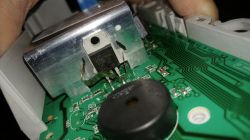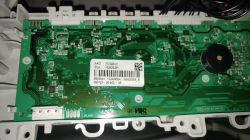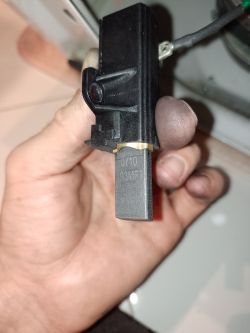Since there are already other posts on this forum for machines which use the same main PCB as this one, I thought I'd describe this repair which I did yesterday, in case others find it useful.
I had a problem on my AEG L62642VI washing machine. The display showed E51. This machine appears to use the Electrolux EWM 2100 PCB (although this is not written anywhere on the PCB).
I found a service manual online: Electrolux Publication no. "599 70 56-70" Edition: 03-2009 Rev. 01. And followed the fault finding chart.
There didn't seem to be a motor fault (also inspected the motor, and added some heatshrink to one of the motor brush cables anyway because the cable insulation was starting to become brittle deteriorate), and E51 persisted after power-cycling the machine, when the main motor harness (J7) was disconnected from the PCB.
I de-soldered the main motor triac (TY1), and saw evidence of some heating between pins 1 and 2, and there was low resistance (~20 ohms) between all the pins when TY1 was out of the PCB, (also present with meter both ways round, ruling out any diode effects).
Replacing this Triac (ST Microelectronics Triac BTB16-700BW) has fixed the fault (completed two complete washes two test spin cycles).
You could also try other BTB16 or BTA17 triacs, if you can't get the exact part (this is 700v version, but the 800v version is more commonly stocked, 600v version is also available, but will have lower voltage spike tolerance).
There was a lot of carbon dust from the motor brushes around the base of TY1, and also at the bottom-right of the PCB, which had been attracted there by electrostatic effects. I removed this with isopropanol, and also some automotive brake cleaner spray (use hydrocarbon-only type - check the safety data sheet to check it doesn't contain other more aggressive solvents, just light hydrocarbons).
If you have any, it might be a good idea to spray both of these areas with a few coats of PCB laquer to try and resist any possible flash-overs because of this accumulated carbon dust.
Text written on my PCB included:
AKO 731028-01
Elux 132624291
MB/Boot 132424604 / B0420009_B
080722 20 463 4F
CPC-E2 94V-0
If this was useful for you, please "positive vote" this.


Dodano po 1 [godziny] 49 [minuty]:
Forgot to say, the other useful publication for this was:
Electrolux Publication no. 599 70 56-70
"Washing machines & Washer-dryers
Guide to diagnostics ENV06 of electronic controls
EWM2100"
Useful pages are:
8: Diagnostics mode
18: Alarm code notes re E51, E52.
46: E51 troubleshooting chart
50: Procedure for checking the commutator motors
89: J7 pinout
Also for the first publication: 599 38 60-23
"Washing machines with electronic control system ENV06"
EWM2100 EWM2500 Technical and functional characteristics"
Page 46: "10.9.1 Power supply to motor"
I had a problem on my AEG L62642VI washing machine. The display showed E51. This machine appears to use the Electrolux EWM 2100 PCB (although this is not written anywhere on the PCB).
I found a service manual online: Electrolux Publication no. "599 70 56-70" Edition: 03-2009 Rev. 01. And followed the fault finding chart.
There didn't seem to be a motor fault (also inspected the motor, and added some heatshrink to one of the motor brush cables anyway because the cable insulation was starting to become brittle deteriorate), and E51 persisted after power-cycling the machine, when the main motor harness (J7) was disconnected from the PCB.
I de-soldered the main motor triac (TY1), and saw evidence of some heating between pins 1 and 2, and there was low resistance (~20 ohms) between all the pins when TY1 was out of the PCB, (also present with meter both ways round, ruling out any diode effects).
Replacing this Triac (ST Microelectronics Triac BTB16-700BW) has fixed the fault (completed two complete washes two test spin cycles).
You could also try other BTB16 or BTA17 triacs, if you can't get the exact part (this is 700v version, but the 800v version is more commonly stocked, 600v version is also available, but will have lower voltage spike tolerance).
There was a lot of carbon dust from the motor brushes around the base of TY1, and also at the bottom-right of the PCB, which had been attracted there by electrostatic effects. I removed this with isopropanol, and also some automotive brake cleaner spray (use hydrocarbon-only type - check the safety data sheet to check it doesn't contain other more aggressive solvents, just light hydrocarbons).
If you have any, it might be a good idea to spray both of these areas with a few coats of PCB laquer to try and resist any possible flash-overs because of this accumulated carbon dust.
Text written on my PCB included:
AKO 731028-01
Elux 132624291
MB/Boot 132424604 / B0420009_B
080722 20 463 4F
CPC-E2 94V-0
If this was useful for you, please "positive vote" this.


Dodano po 1 [godziny] 49 [minuty]:
Forgot to say, the other useful publication for this was:
Electrolux Publication no. 599 70 56-70
"Washing machines & Washer-dryers
Guide to diagnostics ENV06 of electronic controls
EWM2100"
Useful pages are:
8: Diagnostics mode
18: Alarm code notes re E51, E52.
46: E51 troubleshooting chart
50: Procedure for checking the commutator motors
89: J7 pinout
Also for the first publication: 599 38 60-23
"Washing machines with electronic control system ENV06"
EWM2100 EWM2500 Technical and functional characteristics"
Page 46: "10.9.1 Power supply to motor"




